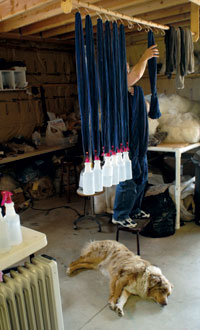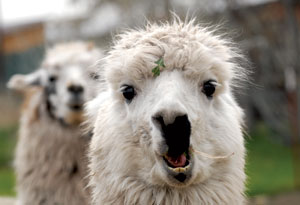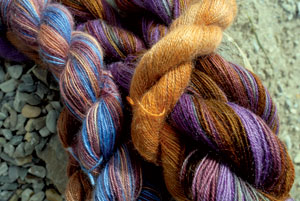For Scott and Diana Blair, owners of Going to the Sun Fiber Mill, life working in a mill is more of an exercise in creativity and artistic freedom than just manning the necessary machinery.
“We’re different because we’re specialized; we’re not just the typical wool mill,” Diana said. “A lot of people, I think, are afraid to go outside of their comfort zone, but we’re both artistic people so, for us, it’s an opportunity to be adventurous. We don’t just sit and push buttons.”
 |
|
Farm dog Casie rests below where Going to the Sun Fiber Mill employee Toni Stocker hangs yarn produced by Mountain Colors. The fiber mill took two string of yarn and ply, or twist, them together. Then they are hung and steamed to hold the ply. |
Going to the Sun Fiber Mill, which celebrated its one-year anniversary last November, processes fiber from throughout the United States – including alpaca and llama from the Blairs’ own herd – into finished yarn.
Located along Farm to Market Road just west of Kalispell, the mill looks like a modern barn or oversized garage from the road. The only signs of something unusual are the dozen llamas and alpacas corralled behind the house and a small wooden sign denoting the mill.
While the Blairs stress the creative side of their work, once inside the mill, it’s initially hard to ignore the industrial.
A steady hum emanates from several of the mill’s seven different, large machines as they sort, mix or weave various animal fibers. Two de-hairing machines, which process dual-coated livestock by separating the outer hair from the downy undercoat, dominate the middle of the room. The larger one is the only such machine in a Montana mill. In the rear of the building, an industrial-size 24-head spinner from Pennsylvania and a 1936 wool-carding machine used to align wool fibers by brushing them with wire teeth sit temporarily idle.
 |
|
Mohawk, a half alpaca and half llama, chews on some dandelions in his pen at Going to the Sun Fiber Mill. |
But, as Diana walks around describing the process and displaying the different end results – an almost daily event for her during the spring and summer months between school tours and curious bypassers – the artistic side becomes more apparent.
In the front of the mill, a variety of yarns, ranging from bright, multi-colored pieces to more traditional mousey-brown woolen threads, are on display. Many are mixes of different fibers, combining, for example, mohair with alpaca or bamboo with bison to create certain textures and strengths. The Blairs often dye the ropes of thread by hand, sometimes adding flash, a glittery mixture, or working alongside the machinery to intertwine colors.
In addition to yarn, the Blairs have equipment to produce fiber battings used in products such as quilts and felting that can be used for blankets or garments.
The couple’s skills mesh nicely for the mill’s operation. Scott, a former lumber grader for Plum Creek, has the expertise needed to operate the equipment; Diana is a long-time knitter who handles the marketing. Both say they have an artistic instinct that encourages them to experiment with their work.
“It’s a very tedious process to make most of these exotics – the ones that have cashmere or bison or yak, more than just wool,” Diana said. “But diversifying has gotten us outside of just local markets and is the reason we’ve been able to keep going and grow so quickly.”
 |
|
An assortment of colorful yarn spun from alpaca and mohair. The mohair is what gives the yarn its shimmer. |
It’s also been an integral part of meeting demand in a changing yarn market, Diana said. About 10 years ago, knitting and crocheting were almost lost as art forms, she said, before making a resurgence, in part, because of luxury yarns.
Because the Blairs rely heavily on area farmers and ranchers to provide them with animal fibers to process into yarn, much of their time is spent educating those groups on how to make the most out of their annual shearing process. Diana hosts seminars throughout the region and the couple makes the rounds at regional fiber festivals, selling their exotic yarn and educating the public about fiber processing.
On July 12-13, the Blairs will be hosting the first-ever Montana Fiber Roundup at the Flathead County Fairgrounds in Kalispell. The festival will include vendors, classes, demos, judging and children’s events as well as a Navajo rug auction. Admission is free.
“These are old-time farmers and ranchers, who are talented at many things, but making yarn usually isn’t one of them,” Diana said. “Rather than them pitching the fiber into a shed when they’re done shearing, we’re showing them how to get the most out of their animals and build their business.”